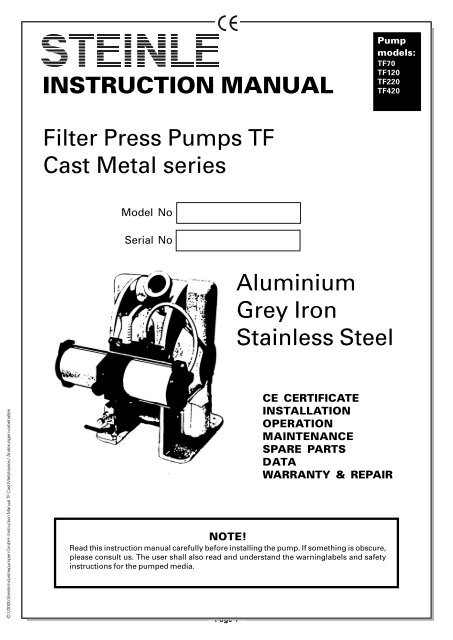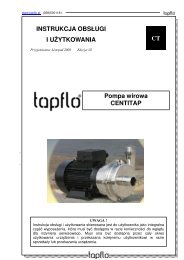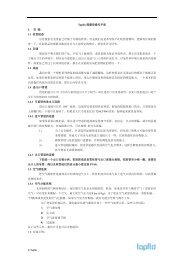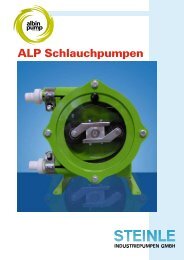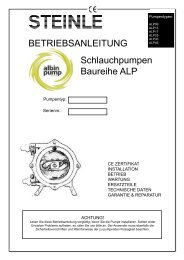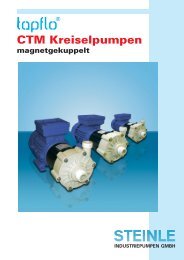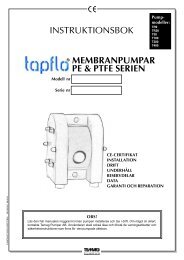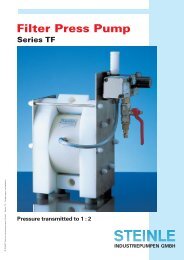1 - Steinle Industriepumpen GmbH
1 - Steinle Industriepumpen GmbH
1 - Steinle Industriepumpen GmbH
Create successful ePaper yourself
Turn your PDF publications into a flip-book with our unique Google optimized e-Paper software.
CHAPTER<br />
INSTRUCTION MANUAL<br />
Pump<br />
models:<br />
TF70<br />
TF120<br />
TF220<br />
TF420<br />
Filter Press Pumps TF<br />
Cast Metal series<br />
Model No<br />
Serial No<br />
Aluminium<br />
Grey Iron<br />
Stainless Steel<br />
© 1/2005 <strong>Steinle</strong> <strong>Industriepumpen</strong> <strong>GmbH</strong> - Instruction Manual TF Cast Metal series / Änderungen vorbehalten<br />
Page 1<br />
CE CERTIFICATE<br />
INSTALLATION<br />
OPERATION<br />
MAINTENANCE<br />
SPARE PARTS<br />
DATA<br />
WARRANTY & REPAIR<br />
NOTE!<br />
Read this instruction manual carefully before installing the pump. If something is obscure,<br />
please consult us. The user shall also read and understand the warninglabels and safety<br />
instructions for the pumped media.
CHAPTER<br />
CONTENTS<br />
CE CERTIFICATE 3<br />
1 INSTALLATION 4<br />
1.1 Receiving inspection 4<br />
1.2 Storage 4<br />
1.3 Foundation 4<br />
1.4 Suction and discharge piping 4<br />
1.4.1 Turnable connections 4<br />
1.4.2 Connection of suction pipe 4<br />
1.4.3 Connection of discharge pipe 4<br />
1.5 Air connection 4<br />
1.5.1 Air treatment system 5<br />
1.5.2 Version TFF, transmission 1:4 5<br />
1.6 Muffler 5<br />
1.7 Example of installation 5<br />
1.8 Scope of supply 6<br />
2 OPERATION 7<br />
2.1 Health and safety 7<br />
2.1.1 Protection 7<br />
2.1.2 Environments in danger of explosion 7<br />
2.1.3 Air pressure 7<br />
2.1.4 Noise level 7<br />
2.1.5 Temperature hazards 7<br />
2.2 Before starting the pump 7<br />
2.3 Starting and operating 8<br />
2.3.1 Dry running 8<br />
2.3.2 Optimizing the pump lifetime 8<br />
2.4 Pump stopping 8<br />
3.5 Dismantling the pump 10<br />
3.5.1 Before the dismantling procedure 10<br />
3.5.2 Mainparts 10<br />
3.5.3 Center block 10<br />
3.6 Assembling of the pump 10<br />
3.6.1 Center block 10<br />
3.6.2 Housing 10<br />
3.6.3 Suction and discharge connection 10<br />
3.6.4 Test run 10<br />
4 SPARE PARTS 11<br />
4.1 Spare part drawing TF70- TF420 11<br />
4.2 Sparepart list TF70 11<br />
4.3 Sparepart list TF120 12<br />
4.4 Sparepart list TF220 12<br />
4.5 Sparepart list TF420 12<br />
4.6 Stocking recommendation 13<br />
4.7 How to order parts 13<br />
4.8 Pump code 13<br />
5 DATA 14<br />
5.1 Performance curves 14<br />
5.2 Dimensions 15<br />
5.3 Technical data 15<br />
6 WARRANTY & REPAIR 16<br />
6.1 Returning parts 16<br />
6.2 Warranty 16<br />
6.3 Warranty form 17<br />
© 1/2005 <strong>Steinle</strong> <strong>Industriepumpen</strong> <strong>GmbH</strong> - Instruction Manual TF Cast Metal series / Änderungen vorbehalten<br />
3 MAINTENANCE 9<br />
3.1 Performance test 9<br />
3.2 Routine inspection 9<br />
3.3 Complete inspection 9<br />
3.4 Location of faults 9<br />
INTRODUCTION<br />
The STEINLE TF filter press pump is very compact pump system, which can be installed directly at the<br />
filter press. The pumps are designed to be safe simple and easy to use and maintain. The construction is<br />
sealless and without rotating parts. The pumps are suitable for almost all different kinds of non aggressive<br />
slurries used by the industry today. It is air driven and needs no further equipment to control the flow rate<br />
when the pressure in the filter press rises up. Pressure regulator and needle valve are already installed at<br />
the pump.<br />
The pumps are based on the aproved Tapflo-pumps, which are exceptionally qualified for this application.<br />
With proper attention to maintenace, the TF-series will give efficient and trouble free operation. This<br />
instruction manual will familiarise operators with detailed information about installing, operating and<br />
maintaining the pump.<br />
Page 2
CHAPTER<br />
CE CERTIFICATE<br />
Declaration of conformity<br />
Machinery directive 98/37/EG<br />
STEINLE <strong>Industriepumpen</strong> declares that:<br />
Product name:<br />
Models:<br />
Filter Press Pumps<br />
TF…<br />
Is in conformity with the essential health and safety requirements and technical<br />
construction file requirements of the EC Machinery directive 98/37/EG.<br />
Manufacturer:<br />
STEINLE <strong>Industriepumpen</strong> <strong>GmbH</strong><br />
Address: Varnhagenstr. 42<br />
D-40225 Düsseldorf<br />
Germany<br />
© 1/2005 <strong>Steinle</strong> <strong>Industriepumpen</strong> <strong>GmbH</strong> - Instruction Manual TF Cast Metal series / Änderungen vorbehalten<br />
Düsseldorf, August 1 st 2003<br />
Michael <strong>Steinle</strong><br />
Managing director<br />
Page 3
1 INSTALLATION<br />
CHAPTER<br />
1.1 Receiving inspection<br />
Although precaution is taken by us when packing and shipping, we urge you to carefully<br />
check the shipment on receipt. Make sure that all parts and accesories listed on the packing<br />
list are accounted for. Immediately report any damage or shortage to the transport company<br />
and to STEINLE .<br />
1.2 Storage<br />
If the equipment is to be stored prior to installation, place it in a clean location. Do not remove<br />
the protective covers from the suction, discharge and air connections which have been<br />
fastened to keep pump internals free of debris. Clean the pump thoroughly before installation.<br />
1.3 Foundation<br />
The pump will operate properly without being fixed to a foundation. If fixation is needed for an<br />
installation, make sure the foundation is able to absorb vibrations. Use the fixing holes on the<br />
foot of the pump housings.<br />
It is essential for the operation of the pump to mount the pump with the feet in a downward<br />
direction (see sketch).<br />
1.4 Suction and discharge pipings<br />
Suction and discharge piping should be fully supported and anchored near to but independent<br />
of the pump. The piping to the pump should be a hose, to prevent undue stress and strain on<br />
the pump connections and the pipings.<br />
1.4.1 Turnable connections<br />
The suction and discharge connections are turnable 180°. This simplifies the assembling and<br />
installation considerably. If you wish to turn the connections, slightly release the pump<br />
housing screws, then screw a threaded nipple into the connection and turn.<br />
1.4.2 Connection of suction pipe<br />
Remember that the suction pipe/connection is the most critical point, especially if the pump is<br />
priming. Just a small leakage will dramatically reduce the suction capability of the pump.<br />
When connecting the suction pipe, following is recommended.<br />
© 1/2005 <strong>Steinle</strong> <strong>Industriepumpen</strong> <strong>GmbH</strong> - Instruction Manual TF Cast Metal series / Änderungen vorbehalten<br />
1) For satisfactory operation, use reinforced hose or corresponding (the suction power may<br />
otherwise shrink the hose). The internal diameter of the hose should be the same as on the<br />
suction connection (at the bottom of the pump) to have best suction capability.<br />
2) Make sure that the connection hose - pump is completely tight, otherwise the suction<br />
capability will be reduced.<br />
3) Always use as short suction pipe as possible. Avoid air pockets which can arise with long<br />
pipings.<br />
1.4.3 Connection of discharge pipe<br />
For this connection it is only recommended a simple and positive flow connection. Use a hose<br />
or flexible piping (minimum one meter) between the discharge connection and any rigid fixed<br />
piping. Coil the hose at least one turn. All components (hose, pipe, valves etc) on the discharge<br />
piping must be designed for minimum PN 10.<br />
1.5 Air connection<br />
Screw the air hose into the air intake on the center block of the pump with for example a<br />
bayonet coupling. For best efficiency, use the same hose diameter as the internal diameter of<br />
the connection on the air intake. The maximum air pressure for TF 70/120 is 8 bar, for TF 220/<br />
420 7 bar. For the TFF-version the maximum pressure is the half of above.<br />
Page 4
CHAPTER<br />
1<br />
INSTALLATION<br />
1.5.1 Air treatment system<br />
The air valve is constructed for oilfree air. Lubrication of the air is not allowed. Maximum air<br />
pressure is 8 bar. As prevention purpose some sort of filtration of the air is recommended.<br />
Dirt in the air can under unfortunate circumstances be the cause of breakdown. Dry air is<br />
also essential. Ice may appear in the air valve if the air is humid.<br />
To facilitate the operation of the pump we recommend an air treatment system connected to<br />
the air supply. These components should be included:<br />
1) Regulator to adjust the air pressure<br />
2) Manometer to read the actual pressure<br />
3) Filter with 5 µm mesh<br />
These components are included our Air treatment system which can be ordered from<br />
STEINLE <strong>Industriepumpen</strong>.<br />
1.5.2 Version TFF with pressure transmission 1 : 4<br />
• The first pressure booster, which is supplied as a single part, has to be installed external.<br />
This booster is connected with the air supply.<br />
• Between this external booster and the booster mounted at the pump, the air connection<br />
hose has to be plugged in. Please leave at least a length 1m of the hose.<br />
• The end pressure of the pump has to be adjusted at the booster mounted on the pump.<br />
1.6 Muffler<br />
The muffler for the pressure booster is supplied as a single part because of transport safety.<br />
This muffler has to be screwed into the hole on the top of the booster.<br />
1.7 Example of installation<br />
© 1/2005 <strong>Steinle</strong> <strong>Industriepumpen</strong> <strong>GmbH</strong> - Instruction Manual TF Cast Metal series / Änderungen vorbehalten<br />
Page 5
1<br />
CHAPTER<br />
INSTALLATION<br />
1.8 Scope of supply<br />
Muffler Booster<br />
Booster<br />
Adjustment knob end pressure<br />
Needle valve<br />
Ball valve<br />
Compressed air connection<br />
Suction side<br />
© 1/2005 <strong>Steinle</strong> <strong>Industriepumpen</strong> <strong>GmbH</strong> - Instruction Manual TF Cast Metal series / Änderungen vorbehalten<br />
Page 6
2<br />
CHAPTER<br />
OPERATION<br />
2.1 Health and safety<br />
The pump must be installed according to local and national safety rules.<br />
The pumps are constructed for particular applications. Do not use the pump on applications<br />
different from that for which it was sold without consulting us to ascertain its suitability.<br />
2.1.1 Protection<br />
In the interest of health and safety it is essential to wear protective clothing and safety goggles<br />
when operating, and/or working in the vicinity of STEINLE pumps.<br />
2.1.2 Environments in danger of explosion<br />
For use in environments in danger of explosion, the pump series TXF with ATEX certification<br />
must be used and it must be properly earthed. Follow the explosion safety rules applicable<br />
at the location for the pump. Consult us for further information. Incorrect installation or use<br />
may cause injury or death to personel in vicinity of the pump.<br />
2.1.3 Air pressure<br />
The maximum air pressure for STEINLE pumps is shown in chapter 1.5. Higher air pressure<br />
than 8 bar can damage the pump and may cause injury to personel in vicinity of the pump.<br />
2.1.4 Noise level<br />
At tests, the noise level from a TF pump has not exceeded 80 dB(A). Under some circumstances,<br />
for example if the pump is operating under high air pressure at low discharge head, the noise<br />
can be inconvenient or hazardous for personel staying for long periods in vicinity of the<br />
pump. This hazard can be prevented by:<br />
– using suitable ear protection<br />
– lower the air pressure and/or raise the discharge head<br />
– lead the outcomming air from the place by connecting a hose from the muffler connection<br />
of the pump.<br />
– use elastomer valve balls EPDM or NBR instead of PTFE or stainless steel, provided that<br />
the elastomer is compatible with the pumped liquid.<br />
© 1/2005 <strong>Steinle</strong> <strong>Industriepumpen</strong> <strong>GmbH</strong> - Instruction Manual TF Cast Metal series / Änderungen vorbehalten<br />
2.1.5 Temperature hazards<br />
Raised temperature can cause damage on the pump and/or pipings and may also be hazardous<br />
for personel in the vicinity of the pump/pipings. Avoid quick temperature changes and do not<br />
exceed the maximum temperature specified when the pump was ordered. See also general<br />
max temperatures based on water in chapter 5 "Data".<br />
2.2 Before starting the pump<br />
– Make sure the pump is installed accordning to the installation instruction (section 1).<br />
– Filling of the pump with liquid before start is not necessary.<br />
– When installing is new or reinstalled, a test run of the pump with water should be conducted<br />
to make sure the pump operates normally and does not leak.<br />
– Make sure that the maximum pressure for the pump and the piping is not exceeded.<br />
Page 7
2<br />
CHAPTER<br />
OPERATION<br />
2.3 Starting and operating<br />
– Open the discharge valve.<br />
– Note! Considering the suction capacity when air is still in the suction pipe, it is<br />
recommended to start with low air pressure/flow in the beginning. This is not necessary<br />
if the pump is filled with liquid before start.<br />
– When the pump has been filled with liquid, the air pressure/flow may be raised to increase<br />
the suction capacity of the pump.<br />
– The performance of the pump can be adjusted through the air supply by adjusting the<br />
needle valve and a pressure regulator. The performance can also be adjusted by normal<br />
flow control on the discharge side of the system.<br />
2.3.1 Dry running<br />
The pump may run dry without any problem for a shorter time. Dry running for a longer<br />
period causes an increase of wear due to the high stroke frequency.<br />
2.3.2 Optimizing the pump lifetime<br />
Running at full frequenzy (maximum air pressure/flow) continiously will cause premature wear<br />
of the components. As a general rule, we recommend to run at half of the maximum capacity of<br />
the pump. For instance, a TF120 pump should run continious maximum at 5 m³/h.<br />
2.4 Pump stopping<br />
When the filter press is filled and the maximum pressure is reached, the must be stopped by<br />
closing the air supply. Before the filter press is opended, the pressure has to drop down to 0.<br />
To stop the pump automatically, various solenoid valves are available.<br />
Stroke sensors can register the frequency of the pump. When the end pressure is reached,<br />
the pump moves slowly and a signal for stopping the filtration can be given.<br />
© 1/2005 <strong>Steinle</strong> <strong>Industriepumpen</strong> <strong>GmbH</strong> - Instruction Manual TF Cast Metal series / Änderungen vorbehalten<br />
Page 8
3 MAINTENANCE<br />
CHAPTER<br />
3.1 Performance test<br />
When installation is new, a test run of the pump should be conducted. Gauge the capacity at<br />
specific air pressure/flow. This information is for use in checking performance as wear takes<br />
place. You will be able to set schedules for maintenance of the pump and to select spare<br />
parts to be kept on stock.<br />
3.2 Routine inspection<br />
Frequent observation of the pump operation is recommended to detect problems. A change<br />
in sound of the running pump can be an indication of weared parts (see below "location of<br />
faults"). Leaking liquid from the pump and changes of performance may also be detected.<br />
Routine inspections should be conducted frequently.<br />
3.3 Complete inspection<br />
The intervals for a complete inspection depend upon the operation conditions for the pump.<br />
The characteristics of the liquid, temperature, materials used in the pump and running time<br />
decide how often a complete inspection is necessary.<br />
If a problem has occured, or if the pump is in need of a complete inspection, see later this<br />
chapter "location of faults" and "dismantling of the pump". You are of course warmly welcome<br />
to consult us for further help.<br />
Weared parts should be carried in stock, see chapter 4 "stocking recommendations".<br />
© 1/2005 <strong>Steinle</strong> <strong>Industriepumpen</strong> <strong>GmbH</strong> - Instruction Manual TF Cast Metal series / Änderungen vorbehalten<br />
3.4 Location of faults<br />
Problem<br />
The pump does not run<br />
The suction is bad<br />
The pump runs irregularly<br />
Bad flow/pressure<br />
Liquid leaks from the pump<br />
Liquid comes out of the muffler<br />
Possible fault<br />
The air pressure is to low<br />
The air connection is blocked<br />
Muffler is blocked<br />
Air valve is defect<br />
Dirt in the pump chamber<br />
Diaphragm breakdown<br />
Suction connection is not tight<br />
Suction connection is blocked<br />
Muffler is blocked<br />
Valve balls are blocked<br />
Valve balls are damaged<br />
Valve balls are blocked<br />
Sealings are defect in air valve or center block<br />
Diaphragm breakdown<br />
Pressurefall in incomming air<br />
Suction or air connection blocked<br />
Muffler is blocked<br />
Air valve is defect<br />
Valve balls worn out/broken<br />
Air in liquid<br />
Diaphragm breakdown<br />
Screws on the housing not properly fastened<br />
Diaphragm breakdown<br />
Page 9
3<br />
CHAPTER<br />
MAINTENANCE<br />
3.5 Dismantling the pump<br />
3.5.1 Before the dismantling procedure<br />
Be sure to drain all liquid from the pump. Cleanse or neutralize the pump thoroughly.<br />
Disconnect the air connection and then the suction and discharge connections.<br />
3.5.2 Mainparts<br />
1) Unscew the steel plate with the pressure booster and unscrew the screws on one side of<br />
the pump housing, place the pump on the side that still has the screws, and lift off the<br />
"loose housing".<br />
2) Turn and lift the suction and discharge connections.<br />
3) Upend the pump and unscrew the other housing. Now the housings are free from the<br />
center block.<br />
4) In order to take out the valve balls, unscrew the valve ball stop in the housing - and the<br />
valve ball is free.<br />
3.5.3 Center block<br />
1) Unscrew one of the diaphragms while pressing the other one towards the center block,<br />
then pull out the second diaphragm together with the diaphragm shaft.<br />
2) Dismantle the circlips which keep the air valve on it's place, press out the air valve with<br />
for instance a wood shaft of a hammer.<br />
3.6 Assembling of the pump<br />
3.6.1 Center block<br />
The center block is assembled in the same way as dismantling it but in opposite direction.<br />
1) Mount the circlip on one side, then turn and push the air valve into the housing.<br />
2) Put the circlip on the other side.<br />
© 1/2005 <strong>Steinle</strong> <strong>Industriepumpen</strong> <strong>GmbH</strong> - Instruction Manual TF Cast Metal series / Änderungen vorbehalten<br />
3) Put the diaphragm with shaft into the center block.<br />
4) Screw the next diaphragm onto the shaft and fix the holes. Sometimes you have to turn<br />
the diaphragms a little back to get the holes fixed.<br />
3.6.2 Housing<br />
The housing is assembled in opposite order to dismantling.<br />
1) Turn the suction and discharge connection to a position so that the in/outlet is in the<br />
direction that you wish.<br />
2) Mount the housing and finally turn the screws equally. Mount the steel plates with the<br />
booster.<br />
3.6.3 Suction and discharge connection<br />
Always make sure that the o-rings and gaskets are fresh, and that they are placed in the<br />
housing before all assembling of the pump.<br />
3.6.4 Test run<br />
We recommend you to conduct a test run of the pump before installing it to the system so no<br />
liquid gets wasted if the pump leaks or perhaps does not start according to wrong assembling<br />
of the pump.<br />
Page 10
4<br />
CHAPTER<br />
SPARE PARTS<br />
3<br />
4.1 Spare part drawing TF70, TF120, TF220 and TF420<br />
Spare parts for the pressure booster are available<br />
in a complete kit, listet as item 70 in the spare<br />
parts list<br />
4.2 Sparepart list TF70<br />
Pos Description Material Qty Article No<br />
Pos Description Material Qty Article No<br />
© 1/2005 <strong>Steinle</strong> <strong>Industriepumpen</strong> <strong>GmbH</strong> - Instruction Manual TF Cast Metal series / Änderungen vorbehalten<br />
11 Housing Alu 2 6-070-11<br />
Cast Iron 2 6-070-11-9<br />
SS316L 2 6-070-11-5<br />
12 Center block Alu 1 6-070-12<br />
13 In/outlet Alu 2 6-070-13<br />
Cast Iron 2 6-070-13-9<br />
SS316L 2 6-070-13-5<br />
15 Diaphragm EPDM 2 6-050-15<br />
PTFE 6-050-15-1<br />
NBR 6-050-15-3<br />
16 Diaphragm shaft AISI 316 1 6-050-16<br />
18 O-ring/gasket (in/outlet) 4 6-070-18<br />
for SS316 pumps: 6-072-18<br />
22 Valve ball stop AISI 316 4 6-070-22<br />
for SS316 pumps: Spring 4 6-072-22<br />
Page 11<br />
23 Valve ball EPDM 4 6-050-23<br />
PTFE 6-050-23-1<br />
NBR 6-050-23-3<br />
PP 6-050-23-4<br />
PU (polyurethane) 6-050-23-7<br />
AISI 316 6-050-23-5<br />
25 Muffler PP 1 6-050-25<br />
27 Circlip Phosph. br. 2 6-050-27<br />
30 O-ring NBR 6 6-050-30<br />
36 Center block sealing PE 4 6-050-36<br />
37 Screw Steel 12 6-070-37<br />
47 O-ring (back up for 36) NBR 4 6-050-47<br />
61 Air valve complete 1 6-050-61<br />
70 Service Kit Booster 1 KTVBA1110
4<br />
CHAPTER<br />
SPARE PARTS<br />
4.3 Sparepart list TF120<br />
Pos Description Material Qty Article No<br />
11 Housing Alu 2 6-120-11<br />
Cast Iron 6-120-11-9<br />
SS316L 6-120-11-5<br />
12 Center block Alu 1 6-120-12<br />
13 In/outlet Alu 2 6-120-13<br />
Cast Iron 6-120-13-9<br />
SS316L 6-120-13-5<br />
15 Diaphragm EPDM 2 6-100-15<br />
PTFE 6-100-15-1<br />
NBR 6-100-15-3<br />
16 Diaphragm shaft AISI 316 1 6-100-16<br />
18 O-ring/gasket (in/outlet) 4 6-120-18<br />
SS316L pumps 6-122-18<br />
22 Valve ball stop AISI 316 4 6-120-22<br />
for SS316L pumps: Spring 4 6-122-22<br />
Pos Description Material Qty Article No<br />
23 Valve ball EPDM 4 6-100-23<br />
PTFE 6-100-23-1<br />
NBR 6-100-23-3<br />
PP 6-100-23-4<br />
PU (polyurethane) 6-100-23-7<br />
AISI 316 6-100-23-5<br />
25 Muffler PP 1 6-050-25<br />
27 Circlip Phosph. br. 2 6-050-27<br />
30 O-ring NBR 6 6-050-30<br />
36 Center block sealing PE 4 6-100-36<br />
37 Screw Steel 12 6-120-37<br />
47 O-ring (back up for 36) NBR 8 6-100-47<br />
61 Air valve complete 1 6-050-61<br />
70 Service Kit booster 1 KTVBA1110<br />
4.4 Sparepart list TF220<br />
Pos Description Material Qty Article No<br />
11 Housing Alu 2 6-220-11<br />
Cast Iron 6-220-11-9<br />
SS316L 6-220-11-5<br />
12 Center block Alu 1 6-220-12<br />
13 In/outlet Alu 2 6-220-13<br />
Cast Iron 6-220-13-9<br />
SS316L 6-220-13-5<br />
15 Diaphragm EPDM 2 6-200-15<br />
PTFE 6-200-15-1<br />
NBR 6-200-15-3<br />
16 Diaphragm shaft AISI 316 1 6-200-16<br />
18 O-ring/gasket (in/outlet) 4 6-220-18<br />
SS316L pumps: 6-222-18<br />
22 Valve ball stop AISI 316 4 6-220-22<br />
for SS316 pumps: Spring 4 6-222-22<br />
Pos Description Material Qty Article No<br />
23 Valve ball EPDM 4 6-200-23<br />
PTFE 6-200-23-1<br />
NBR 6-200-23-3<br />
PP 6-200-23-4<br />
PU (polyurethane) 6-200-23-7<br />
AISI 316 6-200-23-5<br />
25 Muffler PP 1 6-100-25<br />
27 Circlip Phosph. br. 2 6-400-27<br />
30 O-ring NBR 6 6-400-30<br />
36 Center block sealing PE 4 6-200-36<br />
37 Screw Steel 12 6-120-37<br />
47 O-ring (back up for 36) NBR 4 6-200-47<br />
61 Air valve complete 1 6-400-61<br />
70 Service Kit booster 1 KTVBA2100<br />
4.5 Sparepart list TF420<br />
© 1/2005 <strong>Steinle</strong> <strong>Industriepumpen</strong> <strong>GmbH</strong> - Instruction Manual TF Cast Metal series / Änderungen vorbehalten<br />
Pos Description Material Qty Article No<br />
11 Housing Alu 2 6-420-11<br />
Cast Iron 2 6-420-11-9<br />
SS316L 6-420-11-5<br />
12 Center block Alu 1 6-420-12<br />
13 In/outlet Alu 2 6-420-13<br />
Cast Iron 6-420-13-9<br />
SS316L 6-420-13-5<br />
15 Diaphragm EPDM 2 6-400-15<br />
PTFE 6-400-15-1<br />
NBR 6-400-15-3<br />
16 Diaphragm shaft AISI 316 1 6-400-16<br />
18 O-ring/gasket (in/outlet) 4 6-420-18<br />
SS316L pumps: 6-422-18<br />
22 Valve ball stop AISI 316 4 6-420-22<br />
for SS316L pumps: Spring 4 6-422-22<br />
Page 12<br />
Pos Description Material Qty Article No<br />
23 Valve ball EPDM 4 6-400-23<br />
PTFE 6-400-23-1<br />
NBR 6-400-23-3<br />
PP 6-400-23-4<br />
AISI 316 6-400-23-5<br />
PUR cored 4 6-400-23-7<br />
25 Muffler PP 1 6-100-25<br />
27 Circlip Phosph. br. 2 6-400-27<br />
30 O-ring NBR 6 6-400-30<br />
36 Center block sealing PE 4 6-400-36<br />
37 Screw Steel 12 6-420-37<br />
47 O-ring (back up for 36) NBR 4 6-400-47<br />
61 Air valve complete 1 6-400-61<br />
70 Service Kit booster 1 KTVBA4100
4<br />
CHAPTER<br />
SPARE PARTS<br />
3<br />
4.6 Stocking recommendation<br />
Even at normal operation some details in the pump will be weared. In order to avoid expensive<br />
breakdowns we recommend having a few spare parts in stock.<br />
Depending on the severity of the operation and the importance of not having a breakdown we<br />
offer two different spare part sets.<br />
Spare part set No 1 Spare part set No 2<br />
Qty Description Pos<br />
2 Diaphragm 15<br />
4 Valve ball 23<br />
1 Muffler 25<br />
4 O-ringset 18<br />
Qty Description Pos<br />
2 Diaphragm 15<br />
4 Valve ball 23<br />
1 Muffler 25<br />
4 O-ringset 18<br />
1 Diaphragm shaft 16<br />
2 Circlip 27<br />
4 Centerblock seal 36<br />
4/8* O-ring 47<br />
1 Air valve complete 61<br />
* = only TF120<br />
4.7 How to order parts<br />
When ordering spare parts it will simplify if you give the model number from the nameplate<br />
of the pump. The model number tells the size of the pump and materials of the components.<br />
Please include this in your order to us:<br />
1) Model number of the pump (See nameplate)<br />
2) Article number of the detail<br />
3) Description of the detail<br />
4) Quantity of the detail<br />
© 1/2005 <strong>Steinle</strong> <strong>Industriepumpen</strong> <strong>GmbH</strong> - Instruction Manual TF Cast Metal series / Änderungen vorbehalten<br />
4.8 Pump code<br />
The model number on the pump and on the front page of this instruction manual tells the<br />
pump size and materials of the pump components.<br />
Example:<br />
TFF 70 - A N N<br />
1 = Filter press pump model TF<br />
2 = Special executions:<br />
F = Pressure transmission 1:4<br />
S = Air valve SS316/Viton<br />
3 = Pump size<br />
1 2 3 4 5 6<br />
4 = Material of the pump (housings,<br />
center block and in/outlets):<br />
A = Aluminium<br />
C = Cast Iron<br />
S = SS316L<br />
Page 13<br />
5 = Material of the diaphragms:<br />
T = PTFE<br />
N = NBR (Nitrile rubber)<br />
E = EPDM<br />
6 = Material of the valve balls:<br />
T = PTFE<br />
N = NBR (Nitrile rubber)<br />
E = EPDM<br />
P=PP<br />
S = Steel<br />
U = Polyurethane (PU)
5<br />
CHAPTER<br />
DATA<br />
5.1 Performance curves<br />
The performance curves are based on water at 20°C. Other conditions such as higher viscosity<br />
and/or higher specific gravity or higher temperature will change the pump performance.<br />
0 0,5 1 1,5 2 2,5 3 0 1 2 3 4 5 6<br />
0 2 4 6 8 10 12 0 4 8 12 16 20 24<br />
© 1/2005 <strong>Steinle</strong> <strong>Industriepumpen</strong> <strong>GmbH</strong> - Instruction Manual TF Cast Metal series / Änderungen vorbehalten<br />
Example:<br />
A flow rate of 6 m³/h is required and a pressure<br />
of 12 should be achieved. A TF 100 (100 l/min = 6<br />
m³/h) is recommended, which has to be supplied<br />
with 6 bar compressed air.<br />
Page 14<br />
When 16 bar should be achieved, the same<br />
pump must have an air supply of 8 bar. A TFF<br />
100 is recommended, when 8 bar air pressure are<br />
not available. In this case only 4 bar air pressure<br />
are suitable.
5<br />
CHAPTER<br />
DATA<br />
5.2 Dimensions<br />
Aluminium pumps TF 70 – TF 420<br />
A B C D E F G H J<br />
TF 70 150 167 260 230 230 20 116 130 3/4”<br />
TF 120 200 200 356 223 223 27 160 160 1”<br />
TF 220 270 270 400 412 412 35 220 220 1 1/2"<br />
TF 420 350 350 564 586 586 40 290 290 2"<br />
5.3 Technical data<br />
© 1/2005 <strong>Steinle</strong> <strong>Industriepumpen</strong> <strong>GmbH</strong> - Instruction Manual TF Cast Metal series / Änderungen vorbehalten<br />
Page 15<br />
TF70 TF120 TF220 TF420<br />
* Max air pressure (bar) 8 8 7 7<br />
Capacity (m³/h) 4 10 24 32<br />
Max head (bar) 16 16 14 14<br />
Weight (kg) 6 10 25 54<br />
Max suction lift 3 4 5 5<br />
without liquid (m w c)<br />
Max suction lift 8 8 8 8<br />
with liquid (m w c)<br />
Max size of solids (mm) 4 6 10 15<br />
Max temperature (°C) NBR/PTFE diaphm. 120 / 90 120 / 90 120 / 90 120 / 90
6<br />
CHAPTER<br />
WARRANTY & REPAIR<br />
6.1 Returning parts<br />
When returning parts to STEINLE <strong>Industriepumpen</strong> please follow this procedure:<br />
– Consult STEINLE for shipping instructions.<br />
– Cleanse or neutralize and rinse the part/pump. Make sure the part/pump is completely<br />
empty from liquid.<br />
– Pack the return articles carefully to prevent any damage under transport.<br />
Goods will not be accepted unless the above procedure has been complied with.<br />
6.2 Warranty<br />
STEINLE <strong>Industriepumpen</strong> warrants products* of it's own manufacture will be free from<br />
defects in raw material and manufacture under normal use and service for a period of not<br />
more than one year. STEINLE's obligation under this warranty being limited to repair or<br />
replacement of its products which shall be returned to STEINLE Industriepumepn. Follow the<br />
procedures above "returning parts". If a pump or part is received defected, report to STEINLE<br />
immediately. Parts returned to our company must have written authorisation from STEINLE.<br />
This warranty will not apply to any of our products which shall have been used other than for<br />
their intended use.<br />
* Even when products such as diaphragm pumps operate under normal conditions, some parts are subject to<br />
wear and may have to be replaced within one year. Examples of such parts in our diaphragm pumps are;<br />
diaphragms, valve balls, o-rings and gaskets etc. This warranty will not apply to these parts being subject to<br />
wear.<br />
© 1/2005 <strong>Steinle</strong> <strong>Industriepumpen</strong> <strong>GmbH</strong> - Instruction Manual TF Cast Metal series / Änderungen vorbehalten<br />
Page 16
6<br />
CHAPTER<br />
WARRANTY & REPAIR<br />
6.3 Warranty form<br />
Company:<br />
Telephone:<br />
Fax:<br />
Address:<br />
Country:<br />
Contact name:<br />
E-mail:<br />
Delivery date:<br />
Pump type:<br />
Pump was installed (date):<br />
Serial No (stamped on the pump housing):<br />
Description of the fault:<br />
The installation<br />
Liquid:<br />
Temperature (°C): Viscosity (cPs): Spec. grav. (kg/m 3 ): pH-value:<br />
Contents of particles:<br />
%, of max size (mm):<br />
Flow (l/min): Duty (h/day): No of starts per day:<br />
Discharge head (mwc):<br />
Air pressure (bar):<br />
Suction head/lift (m):<br />
Quality of the air (filter, micron?, lubrication?):<br />
Other:<br />
Place for sketch of the installation<br />
© 1/2005 <strong>Steinle</strong> <strong>Industriepumpen</strong> <strong>GmbH</strong> - Instruction Manual TF Cast Metal series / Änderungen vorbehalten<br />
Page 17
CHAPTER<br />
© 1/2005 <strong>Steinle</strong> <strong>Industriepumpen</strong> <strong>GmbH</strong> - Instruction Manual TF Cast Metal series / Änderungen vorbehalten<br />
DISTRIBUTOR:<br />
Page 18<br />
STEINLE <strong>Industriepumpen</strong> <strong>GmbH</strong><br />
Varnhagenstr 42 - D - 40225 Düsseldorf, Germany<br />
Tel: ++49-211-33 32 73 Fax: ++49-211-33 07 55<br />
wwwsteinle-pumpende


